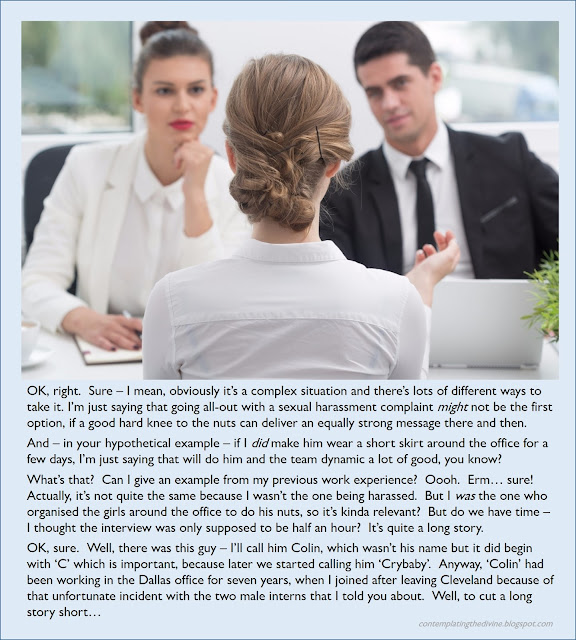OK, so Ken’s question actually gives me a good opportunity
to show you how the new anti-sexist speech code will work in practice. See, Ken’s worried that his free speech
rights will be infringed by our new policies against sexist speech.
And he’s wrong about that, obviously, but it’s OK for him to express
those concerns.
But what about the way he expressed those concerns,
hmm? Was he in breach of the policy? Well, yes, he was. In several ways. So how could he have expressed his concerns in a way that doesn’t involve any kind of sexist behaviour, hmm? Anyone?
No David – women speak first – remember? I know I said ‘anyone’ but you need to wait
at least 30 seconds before attempting to speak to see if any of the women want
to say something first, yeah? We
practiced that before. So… Ken’s
question. What should have have done differently?
Phoebe? That’s right! He didn’t put his hand up, did he? He just started speaking without female
permission. So that’s a violation right
there. Very good.
What about the opinion he expressed? What did he do there that could have been
better?
That’s right, Kate. He disagreed with me. It’s a very common male habit, isn’t it? I guess all the women here could tell stories of men just straight-up disagreeing with them like that. Exactly what the speech code is supposed to stop. But it’s so easy to avoid! There are just so many ways Ken could have expressed his concerns, there,
without disagreeing with something a woman just said.
He could have thanked me and said how much he
agreed with the policy of ending sexist speech, and could I explain a bit more
clearly how this does not infringe his constitutional rights. Or… he could have asked for more advice on how he should express himself, or he could have sought to discover some boundaries, hmmm? Could have asked me what I would like the limits of his free speech to be, yeah? Any of those would have been OK.
Anything else?
How did he address me? Was it respectful?
Well… yes, Kate, he did say “Ma’am”. But he hesitated a bit, didn’t he? And that sounded just a little
disrespectful? So… maybe OK, to be a bit slow with the “Ma’am” in some circumstances,
sure. As long as it’s there. But given the context: he spoke without permission, he also disagreed with me… his hesitation before calling me “Ma’am” was almost like a direct challenge to my authority, wasn’t it? So, yeah,
that’s another violation.
So there’s three distinct violations of the code, which is actualy enough to raise some red flags for action. So I could just call up the app – any time up to three months from the date of the violation, so if you want time to think about it, that’s OK – then I’d double-click on Ken and put the report into the system for disciplinary measures to be taken.
He wouldn’t lose his job, of course, not for only three violations. But he’d lose pay and he’d be placed on the watch list, to undergo some more direct training. There’s an external weekend that he’d find very effective.
Ken? Oh – putting your
hand up, I see! So much better. But I don’t want to hear you just now. Does any other woman want to hear what Ken has to say? No? OK, so put
it down again. That’s right.
Now… we’re going to roleplay a typical office situation… You’re all a team discussing a new project, OK? You’ve each got envelopes describing your role and the team objectives. You’re going to need to plan the research and implentation phases, big marketing push to a female-oriented clientele, yeah? You’re going to need tech skills, marketing savvy and a LOT of cups of coffee, OK? Let’s see how you handle it – using the speech codes, the way we practiced.














































